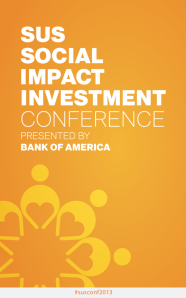
You know, about a year ago I was having breakfast with a good friend over at Services for the Underserved – a well established nonprofit social services provider and affordable housing developer (Hi David!) – and we got to talking about corporate social responsibility. I mean, there are an awful lot of good intentions out there, and a lot of self-serving hoo ha to go right along with it. Where, we asked, could we have a substantive dialogue that advanced our little sector while addressing the needs of the most vulnerable?
Thus was #SUSConf2013 born: the SUS Social Impact Investment Conference. And it’s happening next Wednesday, April 3rd, generously hosted by Bank of America. There are a few (and I mean a few) tickets left. Don’t wait.
Thanks to our amazing Advisory Committee and the wonderful board of SUS, we’ve pulled together a really compelling group of presenters. Speakers and panelists include (in order of appearance):
- Donna Colonna, CEO, Services for the UnderServed
- Kerry Sullivan, President, The Bank of America Charitable Foundation
- Clara Miller, President, The F.B. Heron Foundation
- Antony Bugg-Levine, CEO, Nonprofit Finance Fund
- Arthur Webb, Owner and Principal, Arthur Webb Group
- Tracy Palandjian, CEO and Co-Founder, Social Finance, Inc.
- Dan Letendre, CDFI Lending & Investing Executive, Bank of America
- Margaret Anadu, Vice President, Urban Investment Group, Goldman Sachs
- Scott Budde, Project Director, Sustainable Agriculture Credit Union Research Project
- Jill Schlesinger, Editor-at-Large, CBS MoneyWatch
- Elizabeth Luckett, Director, Impact Investing, Pershing Square Capital Management
- Lisa Hall, President and CEO, Calvert Foundation
We’ve been reaching out to lots of very smart folks to create content that’s meaningful, and we’ve heard a bunch of really great ideas. I wanted to share with you just a tiny bit of the thinking that’s gone into this conference.
Why is SUS hosting this conference? Innovation and change are all around us. SUS strives to play an active role in the trends that shape our collective efforts, and the emerging social impact investment sector holds both promise and challenge.
Nonprofits like SUS are becoming more complex. SUS manages both for-profit and nonprofit entities; makes regular use of structured finance in its work; draws upon management best practices from both the nonprofit and corporate sectors; has earned revenues as an important part of its plan for growth and stability; and can deploy larger capital allocations. These are all the hallmarks of an emerging class of complex nonprofits that blend a mission orientation with a sharp nose for business and the ability to operate at much greater scale.
For-profit social benefit corporations are both partners and competitors. There are a number of areas (affordable housing, education, healthcare, economic development) where for-profit corporations are taking on work previously provided by nonprofits. So you’ve got complex nonprofits intersecting more and more with social benefit corporations, or even traditional corporations seeking to meet needs closer to the bottom of the pyramid.

Convergence: It’s Cool
Convergence is good for social impact investment. Where complex nonprofits and social benefit corporations converge investors can frequently find revenue models capable of repaying principal, and even generating returns.
Social impact capital is no panacea. In spite of the opportunities of social impact investment, we must also carefully balance these against the need for grants, contracts, technical assistance and other resources.
Nonprofits need to drive more of the conversation. Nobody understands the needs and challenges of nonprofits better than the nonprofits themselves. By placing the voices of nonprofit leaders front and center on this issue, we’re advancing the entire sector.
We view this conference as a beginning. We hope to carry the ideas, alliances, and aspirations of this conference into an ongoing conversation with you and our collective stakeholders. We hope to see you there, and thereafter.











